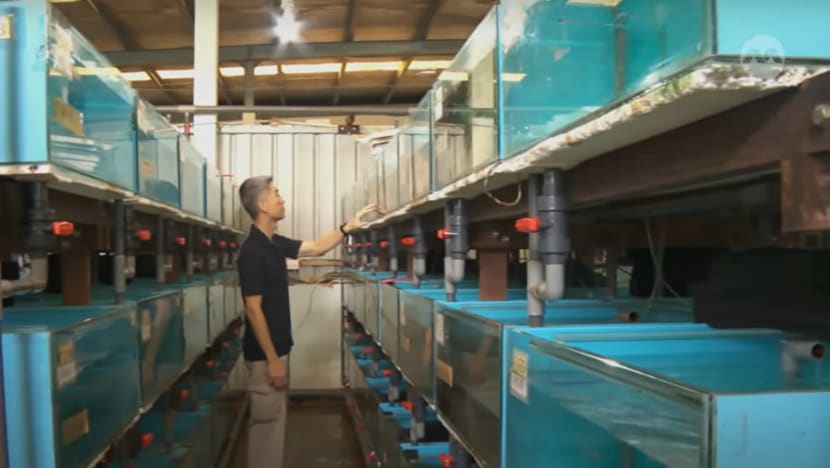Ornamental fish farms turn to new breeding technologies in land-scarce Singapore
Lack of space and rising energy costs have impacted ornamental fish farmers in the country, which has traditionally been a one-stop shop for enthusiasts.

Goldfish being sold at Qian Hu Fish Farm.

This audio is generated by an AI tool.
SINGAPORE: Amid challenges like a lack of space and rising energy costs, some ornamental fish farms in Singapore are using new technologies to optimise land use and improve breeding.
Qian Hu Fish Farm, the biggest among about 60 farms across the island, is pioneering a new system to breed freshwater fish such as guppies and goldfish – some of the most popular aquarium fish species.
This novel tank system allows Qian Hu to breed fish in half the usual amount of time. It also does not discharge waste water during the full grow out period, according to the farm.
The fish are able to absorb nutrients at a faster rate in comparison to traditional methods, with survival rates reaching as high as 80 per cent.
To boost productivity, the authorities are also encouraging farms to embrace technology.
So far, the National Parks Board (NParks) has awarded S$700,000 (US$530,000) in grants to four farms to support solutions such as automatic fish counters and water treatment systems.
As of September, about a quarter of the ornamental fish farms in Singapore operate indoors in industrial buildings, including five that opened their doors between last year and this year.
However, some smaller players have exited the scene in recent years due to uncertainty over land leases.
UPHILL BATTLE FOR LAND USE
Qian Hu’s land lease along Jalan Lekar in Choa Chu Kang is also set to expire in about a year. It is now working to renew its lease.
“We are doing a lot of research into a new farming system, where we will write a proposal (to submit to the authorities) for higher productivity farming methods,” said its research and development manager Yeo Kian Kuang.
He added that the farm currently has a large plot of land with an outdoor mud pond where it breeds arowana, but it will invest in technology to convert this into a high-tech farming system.
“Traditional ornamental farmers in the region - they are still using primitive methods, like in the outdoor ponds where they face challenges in the climate and also fish diseases,” Mr Yeo added.
However, farms constantly face an uphill battle for space, especially in land-scarce Singapore.
According to NParks, only 1 per cent of the country’s land is set aside for agricultural purposes.
The agency said it has been making plots of land available for ornamental fish farms, with these plots varying in size to meet different needs.
Companies also have the option to move their operations into indoor spaces, subject to approval from the relevant agencies. NParks said this could include a combination of farming, import and export, and retail or e-commerce activities.
The Singapore Aquarium Fish Exporters Association said the industry has a pressing need for space, given how Singapore has traditionally been a one-stop shop for customers who do not want to get ornamental fish from multiple sources.
“We bring in fishes from all around the world, be it South America, Africa and Asia,” said the association’s chairman William Chew.
“When customers buy from Singapore, they get to amalgamate all kinds of fishes into one single order, and that really helps to lower the import cost for them.”
The association is in constant dialogue with NParks to relay the challenges that the industry faces, he added.

AMONG TOP GLOBAL EXPORTERS
Singapore has also remained one of the world’s top exporters of ornamental fish. According to the United Nations Comtrade Database, Singapore’s export value for ornamental fish in 2022 was around US$35 million.
Farms told CNA that business has risen 10 per cent post-pandemic. Interest in fishkeeping initially soared during the COVID-19 outbreak in 2020 and 2021.
However, finding a space big enough to quarantine these fish can be tough.
To address this, NParks announced a S$7.5 million productivity grant last year to help the landscape and animal sectors, which include ornamental fish farms. The fund helps businesses defray the cost of purchasing equipment and technology.
Mr Chew, who manages Sanyo Aquarium in the Khatib area, is also using new technology at his firm, though he said it has its limitations.

The import and export company uses an artificial intelligence programme to count the number of fish it has.
“Of course, we need to check the fish every day. We have tried to use AI imagery to try to check the fishes. But the thing is, nothing beats the human eye,” he said.
"Little telltale signs from the fish, like flashing of the fins … These are things that will tell you whether the fish need additional care, and current technology-wise, it is quite difficult to check on all the tanks that we have,” he added.
Despite these challenges, industry players said they remain hopeful as they expect global demand for ornamental fish to remain stable.
“Through these years, we have built up good rapport with our customers, and through the COVID years, we have seen good numbers,” said Mr Chew.
“Right now, the market is stable and we continue to work on trying to offer new varieties of fish for our customers and also good healthy fish.”

















